All high resolution versions are in JPEG (JPG) format, 16 million colors, 15:1 compression.
Alexander the Great
 Click here to download a high resolution version of this image (4.1 K).
Click here to download a high resolution version of this image (4.1 K).
A silver teradrachm coin minted late in Alexander's reign. This coin is an "official" portrait. They were produced in such huge amounts that, even today, they are not exceptionally rare and are available on the market at a modest price.
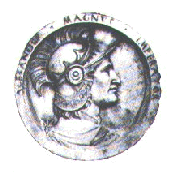 Click here to download a high resolution version of this image (13.6 K).
Click here to download a high resolution version of this image (13.6 K).
Alexander as he appears in a medallion carved on the facade of the Charterhouse in Pavia.
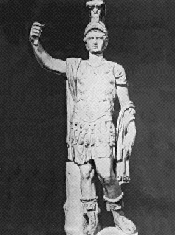 Click here to download a high resolution version of this image (23.3 K).
Click here to download a high resolution version of this image (23.3 K).
Statue of Alexander. Source unknown.
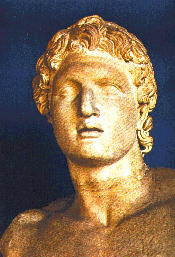 Click here to download a high resolution version of this image (117.6 K).
Click here to download a high resolution version of this image (117.6 K).
Statue of Alexander found in Magnesia. Probably by the sculptor Menas in the late second century.
 Click here to download a high resolution version of this image (13.3 K).
Click here to download a high resolution version of this image (13.3 K).
Statue of Alexander. Source unknown.
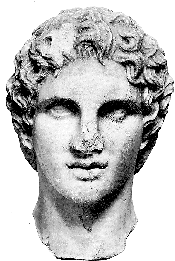 Click here to download a high resolution version of this image (64.0 K).
Click here to download a high resolution version of this image (64.0 K).
An Idealized marble representation of a youthful Alexander. Possibly an original work by Leochares. Acropolis Museum 1331.
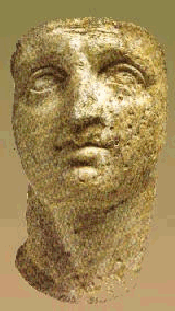 Click here to download a high resolution version of this image (42.4 K).
Click here to download a high resolution version of this image (42.4 K).
Statue of Alexander. Source unknown.
 Click here to download a high resolution version of this image (6.9 K).
Click here to download a high resolution version of this image (6.9 K).
This head of Alexander from Pergamum, in marble, was probably executed during the reign of Eumenes II (197-159), and based on an original made during Alexander's lifetime.
 Click here to download a high resolution version of this image (2.6 K).
Click here to download a high resolution version of this image (2.6 K).
This bust is known as the Azara Herm. It is from the Musee du Louvre, Paris, no. MA 436. Roman copy of a Greek original possibly by Lysippos, Alexander's official court sculptor. Unlike the greatly idealized representations of Alexander, the Azara Herm has the distinct look of a portrait from life.
 Click here to download a high resolution version of this image (27.3 K).
Click here to download a high resolution version of this image (27.3 K).
Close up of the Azara Herm.
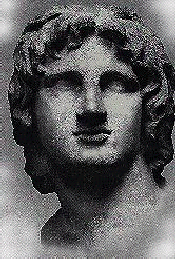 Click here to download a high resolution version of this image (22.0 K).
Click here to download a high resolution version of this image (22.0 K).
From the British Museum 1857. The marble head in The British Museum is a third century Hellenistic representation found in Egypt and is probably a cult statue connected with his worship. It is a good example of the exageration of literary descriptions of Alexander which include the long hair, the tilted head, and the upward looking eyes.
 Click here to download a high resolution version of this image (4.7 K).
Click here to download a high resolution version of this image (4.7 K).
From the Ny Carlsberg Glyptothek Nr 574. This highly romanticised marble is of the third century B.C. Alexandrian school.
 Click here to download a high resolution version of this image (4.4 K).
Click here to download a high resolution version of this image (4.4 K).
From the Kanellopoulos Museum 2497. A Roman marble of the second century B.C. which amply represents how far the romanticisation of Alexander images was taken.
Return to Contents
Olympias and Philip
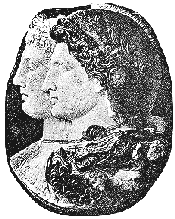 Click here to download a high resolution version of this image (35.9 K).
Click here to download a high resolution version of this image (35.9 K).
Stone relief of Alexander and Olympias. Source unknown.
 Click here to download a high resolution version of this image (204.8 K).
Click here to download a high resolution version of this image (204.8 K).
A Hellenistic Greek onyx cameo of the third century B.C. of Alexander and Olympias.
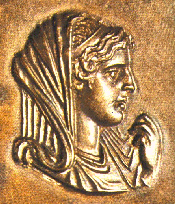 Click here to download a high resolution version of this image (97.0 K).
Click here to download a high resolution version of this image (97.0 K).
A relief of Olympias. Source unknown.
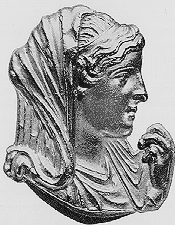 Click here to download a high resolution version of this image (97.0 K).
Click here to download a high resolution version of this image (97.0 K).
Same relief of Olympias in grey. Source unknown.
 Click here to download a high resolution version of this image (97.0 K).
Click here to download a high resolution version of this image (97.0 K).
Stone relief of Philip II. Source unknown.
Return to Contents
Friends and others
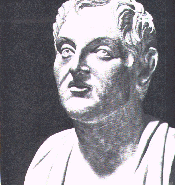 Click here to download a high resolution version of this image (71.0 K).
Click here to download a high resolution version of this image (71.0 K).
Bust of Aristotle (384-322 B.C.) who acted as Alexander's tutor.
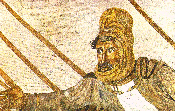 Click here to download a high resolution version of this image (219.5 K).
Click here to download a high resolution version of this image (219.5 K).
Detail of Darius from the Issus mosaic.
Return to Contents
Battle Scenes
 Click here to download a high resolution version of this image (809.3 K).
Click here to download a high resolution version of this image (809.3 K).
From the Museo Nazionale, Naples, Italy. Dated from the late 2nd century. B.C., copy of a painting dated to c. 300 B.C.
Traditionally this scene reresents the turning-point at Issus when Darius fled the battle; but Philoxenus, the artist from whose painting the mosaic was copied, may have incorporated elements from other battles. Alexander's personal moment of peril seems borrowed from the Granicus, and the confrontation also has echoes of Gaugamela.
This description is taken from a site that has many detailed photos of the mosaic:
This mosaic depicts a battle between Alexander the Great and the Persian king Darius, probably the Battle of the Issus River in November of 333 B.C. It is in opus vermiculatum, with over one and a half million tesserae, none larger than 4 mm., in four colors: white, yellow, red, and black. The minuteness of the tesserae enables incredibly fine detail and painterly effects, including remarkable portraits of Alexander and Darius.
The border of this huge mosaic consists of large stones in a dentate pattern . In the corners are rosettes. Within the border along the bottom of the picture is a blank brown stripe, which some consider to be part of the picture, balancing the white expanse of sky at the top, while others argue that it is simply part of the frame.
The composition of the mosaic is dominated by the two protagonists: On the left, Alexander, with his head uncovered, rushes forward on his horse Bucephalus. He holds a spear with which he has skewered a Persian soldier, who has rushed to the defence of Darius. With Alexander appear his helmeted Macedonian soldiers, although little remains of them due to damage of the left side of the mosaic. On the right Darius, wearing a Persian cap, stretches out his hand to his wounded defender, while his charioteer whips the horses to flee toward the right. Around him are his Persian soldiers who mill in confusion in the background, their faces filled with fear and determination. One Persian, however, to the right of the dying defender of Darius, is intent upon Alexander, and holds his sword in his hand, ready to attack.
There are many details which emphasize the terror and confusion of the battle. The horse of the Persian defender of Darius collapses beneath him while he writhes in agony on Alexander's spear. Below Darius in his chariot, a Persian soldier, staring in horror at this scene, attempts to hold a rearing horse. The hindquarters of this horse project into the middle ground of the picture, giving it a sense of depth. To the right, a soldier is being crushed under the wheels of Darius' chariot. His face is reflected in the shield which he holds. Further to the right appear the terrified horses of the chariot team, trampling upon another unfortunate Persian.
The composition of the mosaic is dominated by diagonals. The center is dominated by the intersecting diagonals of the Persian speared by Alexander and the Persian restraining the rearing horse. Two other sets of intersecting diagonals are provided by the figures of Darius and his charioteer and by Alexander and the wounded Persian. The lances in the background of the picture also carry on the diagonal motif.
The setting of the battle is very stylized. In the background appears a tree with bare twisted limbs whose diagonals continue the unifying compositional motif of the mosaic. The tree also serves as a formal vertical counterweight to the Persian king and his charioteer, who rise above the battle fray. In the foreground are discarded weapons and rocks, which serve to define the space between the viewer and the battle scene.
The Alexander mosaic is thought to be based on a painting which Philoxenus of Eretria created for King Cassander of Macedonia. The painting is described by Pliny the Elder as representing "the battle of Alexander with Darius." Certain inconsistencies in the mosaic point to its derivation from another source. In the center of the composition appears a helmeted head to the right of the rearing horse. Two lance shafts come from the left and abruptly stop behind this heád. To the right of the same head appears a head of a horse and beneath this are the hindquarters of another horse, neither of which is logically completed. Among the four horses of Darius' chariot there are parts of a white horse which do not fit together anatomically. Above these horses is a Persian soldier who appears to have two right hands, one on his head and the other raised in the air. These details provide evidence that the mosaicist misunderstood details of the original.
Nevertheless, the overall effect of the mosaic is masterful. The expert blending of the colors of the tesserae and the careful control of the overall composition create a scene which comes to life with all the horror and confusion of battle. The Alexander mosaic is a truly great work, unmatched in the history of Roman art.
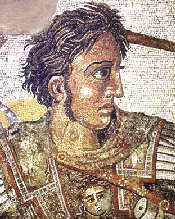 Click here to download a high resolution version of this image (62.0 K).
Click here to download a high resolution version of this image (62.0 K).
This close up of Alexander is from the mosaic of the battle of Issus from the Museo Nazionale, Naples, Italy.
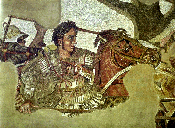 Click here to download a high resolution version of this image (103.0 K).
Click here to download a high resolution version of this image (103.0 K).
This close up of Alexander and Bucephalas is from the mosaic of the battle of Issus from the Museo Nazionale, Naples, Italy.
Return to Contents
Miscellaneous
 Click here to download a high resolution version of this image (329.5 K).
Click here to download a high resolution version of this image (329.5 K).
Alexander and Roxane, his wife from India.
 Click here to download a high resolution version of this image (50.7 K).
Click here to download a high resolution version of this image (50.7 K).
Alexander taming Bucephalas. A bronze statuette, probably Hellenistic-Etruscan (? fourth centrury B.C.)
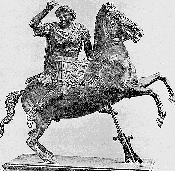 Click here to download a high resolution version of this image (56.5 K).
Click here to download a high resolution version of this image (56.5 K).
Alexander on Bucephalas - a bronze statuette found at Herculaneum, probably of the late Hellenistic period, and adapted from Lysippus' group set up at Dium to commemorate the victory of the Granicus. The general's scarf and the symbolic rudder show that victory involved crossing the river.
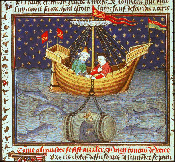 Click here to download a high resolution version of this image (235.8 K).
Click here to download a high resolution version of this image (235.8 K).
Alexander being lowered underwater in a glass barrel to explore the wonders of the deep. From The Old French Prose Alexander Romance manuscript, Rouen, 1445.
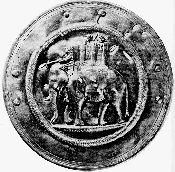 Click here to download a high resolution version of this image (113.5 K).
Click here to download a high resolution version of this image (113.5 K).
An early Hellenistic silver shield, decorated with a war elephant.
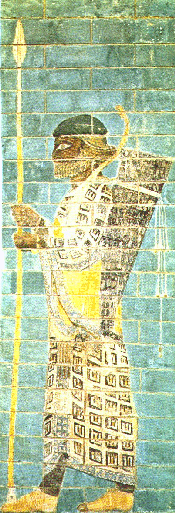 Click here to download a high resolution version of this image (113.5 K).
Click here to download a high resolution version of this image (113.5 K).
A Persian bodyguard, in glazed brick, from the palace at Susa.
Return to Contents